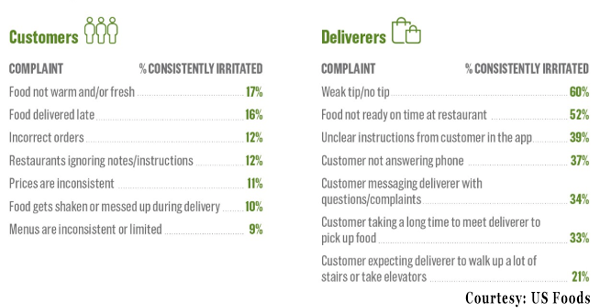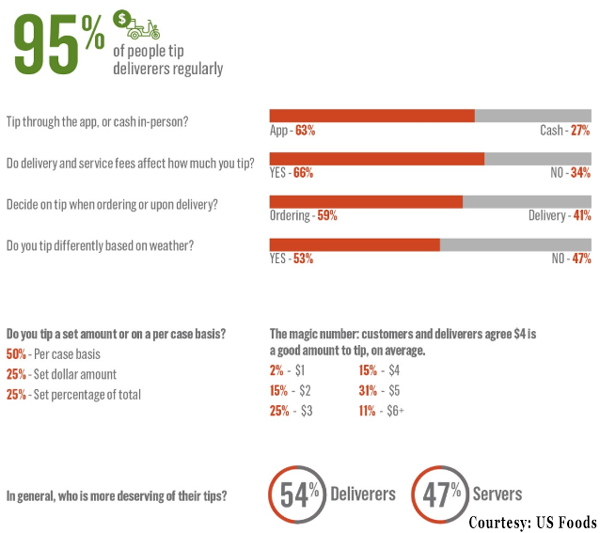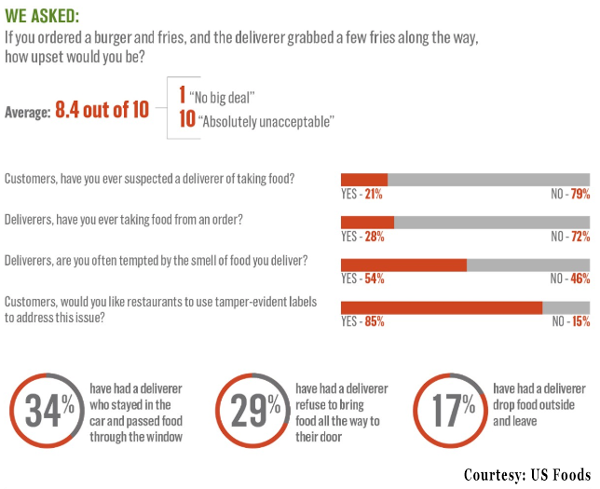A new survey from US Foods digs into the grievances consumers have with third-party delivery and provides some eye-popping insight into some of the less-than-ethical things couriers do on the job.
The food supplier conducted a national survey of 1,500 delivery consumers for one part and 500 delivery drivers for the other. Both surveys were conducted between May 9 and May 13 of 2019. While it contains some interesting nuggets, it’s not a massive study given the millions of third-party consumers and the legions of drivers who support them.
The average consumer respondents reported having two delivery apps, and they used them three times a month. The most popular app among the group was Uber Eats, followed by Grubhub, DoorDash and then Postmates. On average, consumers said they would accept a 40-minute wait. Just one in four consumers would accept a delivery time of an hour, but 31 percent said they would accept just 30 minutes.
In Food On Demand’s own consumer research, the delivery times range from 39 to 45 minutes, so the industry is doing a pretty good job of meeting consumer expectations.
As for how they use the services, by a slight margin (54 percent), they start with a restaurant in mind before ordering compared to opening the app and looking for ideas (46 percent).
Now for the gripes, there were many issues highlighted in the survey, as seen in the chart below.

The biggest complaint called out by 17 percent of respondents as consistently irritating was poor food quality, either not warm or not fresh. That was followed closely by 16 percent of respondents who said late orders were consistently irritating. Wrong orders, ignored notes, inconsistent prices and jostled food all came in between the 10-12 percent range.
For the drivers, there were more consistently irritating factors. Given the nature of the job, the biggest irritation was low or complete lack of a tip. That’s something a lot of drivers call out in forums and elsewhere, and something they largely agree third-party services could do a better job of managing.

Of course, that’s tricky for the providers as there is a lot of confusion about who gets that delivery fee (it’s the provider). Addressing that confusion could potentially lead consumers to rethink the overall cost of delivery when they add a reasonable tip on top of the delivery fee whether it originates from a provider or their chosen restaurant. Some 95 percent of respondents said they tipped drivers regularly, but 66 percent said the service fees affect how much they tip.
The second biggest irritation for drivers is poor food timing. The services and all their algorithms attempt to get drivers to the restaurant exactly when the food is ready to go, but that assumes restaurants are putting delivery orders in stream with dine-in orders. Some restaurants simply wait for the driver to show up, making those billion-dollar algorithms and predicted times absolutely useless.
That practice also keeps drivers standing around in the restaurant annoyed at the wasted time during which they could be making money. With 52 percent of respondents saying that is a consistent irritation, it’s a big issue that makes the experience worse for the delivery service, the restaurant, the driver and consumers. The onus here seems to be on restaurants, but as delivery becomes more commonplace and consistent, one would hope restaurants stop worrying about a driver not showing up and waiting to prepare the food.
Some other big irritants for drivers are bad instructions from consumers (39 percent) and high expectations of drivers about climbing stairs or long elevator rides (21 percent). In line with that irritant is customers simply not answering their phones (37 percent)—and come on, who are these people spending $25 plus on dinner and just ignoring their sole contact with the driver?

Drivers, however, have their own quirks, as seen in the survey. Drivers really do take food on occasion, with 28 percent of drivers saying they had taken food from an order. That’s even higher than the 21 percent of consumers who suspected their courier snuck a bite.
And 54 percent of drivers said they had been tempted by the smell of the food they were delivering. In all, 85 percent of consumers in the survey said they wanted restaurants to use tamper-evident labels to address this. So, restaurant operators, get some stickers for those delivery bags—especially if your food smells too good to ignore.
See the full survey at US Foods.


